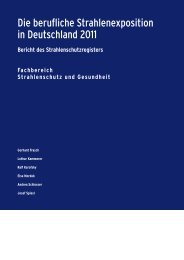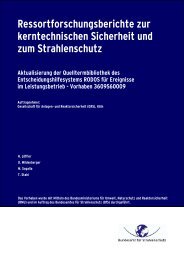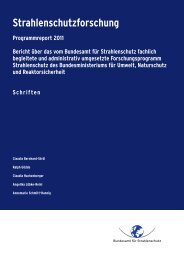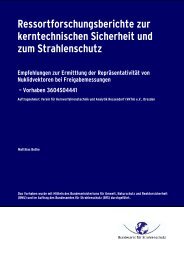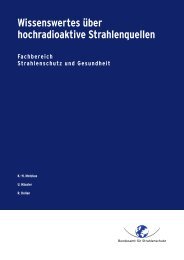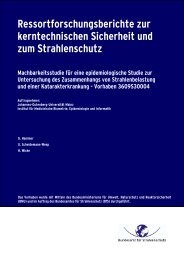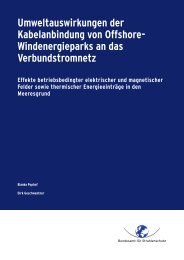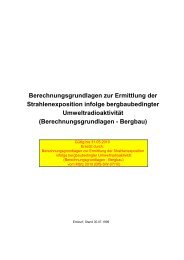Programmreport 2012 - DORIS - Bundesamt für Strahlenschutz
Programmreport 2012 - DORIS - Bundesamt für Strahlenschutz
Programmreport 2012 - DORIS - Bundesamt für Strahlenschutz
Erfolgreiche ePaper selbst erstellen
Machen Sie aus Ihren PDF Publikationen ein blätterbares Flipbook mit unserer einzigartigen Google optimierten e-Paper Software.
Based on an extensive literature study, measurement and computation methods were developed within the<br />
study “Exposure to non-ionising radiation with frequencies in the terahertz range - development and<br />
application of methods (3610S80001)“ in order to determine the human exposure in the THz frequency<br />
range. To measure the exposure caused by THz systems a two-stage method was proposed: First, using a<br />
lens-coupled THz CMOS camera a hotspot is determined at the point of exposure, respectively the propagation<br />
direction of the beam, and is followed by the measurement of the power density distribution in the beams<br />
cross-section at the exposure location. Therefore, either a direct beam sampling with a THz CMOS direct detector<br />
of small aperture was used or alternatively (in case of a Gaussian-shaped power density distribution)<br />
the knife-edge beam-profiling method. For the numerical dosimetry detailed models of the human skin as well<br />
as of the eye, and field excitation models, e.g. for a Gaussian beam excitation, were generated. The dielectric<br />
material parameters in THz frequency range - required for the calculation of the internal body field and SAR<br />
distributions, but not sufficiently described in the literature - were determined by the "effective medium theory".<br />
Moreover, for the exposure assessment the THz-related temperature increases, based on the SAR as heat<br />
source, were considered.<br />
The aim of the research project “Determination of general public exposure to novel cellular mobile<br />
radio technologies (3611S80002)“ is primarily the measurement and analysis of the general public’s exposure<br />
in the vicinity of LTE and TETRA BOS base stations. Concerning LTE measurements at 102 systematically<br />
and 75 randomly chosen measurement points, exposures extrapolated to the maximal operational<br />
state of the station were found to be between 0.002 and 7.28% of the ICNIRP 1998 field strength reference<br />
levels (median 0.70%). The instantaneous exposure in terms of field strength was smaller by factors between<br />
3.1 and 17.2. TETRA BOS exposure measurements at 40 systematically and 40 randomly chosen points resulted<br />
in extrapolated exposures between 0.03 and 4.63% of the field strength limit (median 0.46%). The instantaneous<br />
exposure was smaller by factors between 2.1 and 4.4 with respect to field strength. The LTE and<br />
TETRA BOS exposure is very similar to the exposure around GSM and UMTS base stations with regard to<br />
order of magnitude and spatial distribution.<br />
It can be concluded, that the base stations of the novel cellular mobile radio techniques LTE and TETRA BOS<br />
cause an exposure increase to the general public. The overall exposure to fixed radio transmitters, however,<br />
is still low (median smaller than 2% of the field strength limit). At the investigated base stations the power related<br />
mobile phone exposure increase was 37% for LTE and 47% for TETRA BOS, both related to maximal<br />
operational state of the station. On average a 22% contribution of LTE and 30% of TETRA BOS to the overall<br />
RF exposure was measured. These values are representative primarily for the direct vicinity of the selected<br />
stations and should not be interpreted as area or population averaged exposure increase.<br />
SUBJECT AREA 09 - GERMAN MOBILE TELECOMMUNICATION RESEARCH PROGRAMME<br />
Within the project “Age dependent effects of high-frequency electromagnetic fields on the development<br />
and differentiation of the CNS of juvenile laboratory rodents“, female Wistar-rats, from an age of 14 days<br />
to 19 months, were exposed for 2 hours per day, 5 days per week in the head reagion to mobile phone electromagnetic<br />
fields (900 MHz GSM). The SAR values were 0, 0.7, 2.5, and 10 W/kg. The primary exposure of<br />
the head region was done by fixating the animals in restraining tubes of different sizes. During the experiment,<br />
three blocks of behavioral and learning tests were performed in juvenile, adult, and pre-senile animals (RotaRod,<br />
Morris-water maze, 8-arm maze, and open field). Between the groups of the exposed and the<br />
sham-exposed animals no profound differences could be identified. A histopathological analysis revealed no<br />
higher tumor incidence in the central nervous system due to exposure. The body weights of the exposed /<br />
sham-exposed animals were not different during the first year, and thereafter only marginally different from<br />
those of the the cage controls, so that the effect of stress as confounder was probably negligible.<br />
XXV



